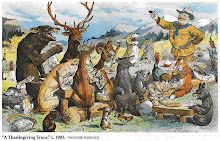Despite MT gov's claims, no big wolf kills planned
On Friday, Montana Fish, Wildlife and Parks spokesman Ron Aasheim said the agency was awaiting a response from federal officials on a pending state petition to kill those wolves, in an area known as the Bitterroot Valley. A decision from the U.S. Fish and Wildlife Service is due within six weeks.
Schweitzer this week also notified U.S. Interior Secretary Ken Salazar that he had directed wildlife officials to shoot "whole packs that kill livestock, wherever this may occur."That directive was revised Friday to reflect less-severe policies already in place for the state's more than 500 wolves.
Projections made last year by wildlife officials showed that killing off all packs that attack cattle, sheep or other livestock would have quickly reduced wolf numbers below sustainable levels.
The governor's natural resources adviser, Mike Volesky, told The Associated Press that wildlife agents had "discretion to use whole-pack removal" — not a mandate to do so.
"The letter probably dealt with the issue inartfully," Volesky wrote in an e-mail response. "It's usually better to leave some discretion to the experts on the ground, who can then react to specific circumstances."
Roughly one out of every three packs will kill livestock in any given year. If every livestock-killing pack was eliminated, within four years the number of breeding packs would be reduced by half, to just 14, according to the state's projections. That is below the level considered necessary for Montana's wolf population to remain viable over the long-term.
Although the state has authority to take out problem packs — and did so nine times in 2009, the most recent year for which data was available — its longstanding practice has been to try other methods first in most instances. That includes non-lethal measures and shooting wolves from attacking packs one at a time until the problem stops.
More than 600 wolves have been killed in Montana since the animals were reintroduced to the Northern Rockies by the federal government in the mid-1990s. Most were shot by government wildlife agents in response to livestock attacks.
"The idea is to address the depredation problems and still maintain a recovered wolf population, which we are committed to doing," Aasheim said.
Schweitzer's show of defiance was welcomed by some in Montana, where ranchers and hunters have grown increasingly frustrated with federal restrictions against public wolf hunts.
But they were rejected by the Interior Department as taking the wrong approach and generated alarm among wildlife advocates.
The governor also encouraged ranchers in northern Montana to shoot wolves that harass their livestock — currently prohibited north of Interstate 90 — and said state game wardens would no longer investigate wolf killings in that part of the state.
"It sends the wrong signal to would-be wolf poachers that they could say they are protecting livestock and eliminating wolves," said Michael Leahy with Defenders of Wildlife.
Wolf poaching laws still will be enforceable by federal wildlife agents.
Lawsuits brought by advocacy groups including Leahy's have kept gray wolves in the Northern Rockies on the endangered list for a decade since the animals exceeded the government's original recovery goals.
There are now at least 1,700 wolves in Montana, Idaho, Wyoming, Washington and Oregon — more than five times the goal to maintain at least 300 in the region.
Public hunting for wolves has been banned since they were listed as endangered in 1974, except for a brief period when they came off the list in Idaho and Montana in 2009.
Several measures now before Congress would lift protections for the animals regardless of an order last year from U.S. District Judge Donald Molly that had restored their endangered status.
___










No comments:
Post a Comment